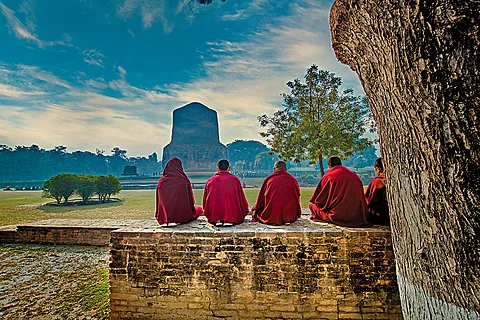
- Destinations
- Experiences
- Stay
- What's new
- Celebrating People
- Responsible Tourism
- CampaignsCampaigns
- Subscribe
- Buy Now

Sarnath, an ancient Buddhist site in Uttar Pradesh, India, is making steady progress towards becoming a UNESCO World Heritage Site. Currently listed on UNESCO’s tentative list under the title "Ancient Buddhist Site, Sarnath", its inclusion reflects ongoing efforts to achieve full recognition and global heritage status.
Sarnath is one of the four key sites associated with the life of the Buddha, along with Lumbini, Bodhgaya, and Kushinagar. It holds immense historical and spiritual importance as the place where the Buddha delivered his first sermon after attaining enlightenment—an event known as the Turning of the Wheel of Dharma. This moment marked the beginning of the spread of Buddhist teachings.
Today, Sarnath is a major pilgrimage destination for Buddhists from around the world. Visitors are drawn to its sacred Deer Park, the ancient stupas, temples, and the famous Ashokan Pillar, all of which reflect its rich religious and cultural legacy.
The inclusion of Sarnath on UNESCO’s World Heritage Tentative List since 1998 highlights its global importance. The original proposal, submitted by the Archaeological Survey of India, lacked the necessary detail and comprehensiveness. A revised and more robust nomination was submitted in 2019, which is still under review.
Achieving UNESCO World Heritage status would bring international recognition to Sarnath, reaffirming its significance in the shared heritage of humanity. This recognition is likely to attract increased tourism, offering economic benefits to the region and greater visibility on the global stage. Furthermore, it would encourage stronger preservation and site management efforts, ensuring that its archaeological and spiritual value is protected for future generations. As more people from around the world come to experience Sarnath, it would also promote cultural exchange and deeper understanding of Buddhism’s enduring influence.
Located just 10 km from Varanasi (formerly Benaras), Sarnath was once a prominent centre of learning. It was here that the Buddha founded the first Buddhist Sangha, comprising 60 disciples, following his first sermon.
One of Sarnath’s most prominent landmarks is the Dhamek Stupa, a massive cylindrical structure believed to mark the exact spot where the Buddha delivered his first sermon. Its stone base is adorned with intricate carvings, reflecting the artistic excellence of the time.
Among Sarnath’s most notable landmarks is the Mulagandhakuti Vihara, a modern temple adorned with striking frescoes by Japanese artist Kosetsu Nosu and housing a golden idol of the Buddha.
In addition to these key sites, Sarnath is home to several other stupas, monasteries, and temples built by Buddhist communities from around the world. Notable among them are the Thai Temple, Japanese Temple, and Chinese Temple, each showcasing unique architectural styles and further enriching the spiritual and cultural landscape of this historic site.
Where is the site located?
It is situated about 10 kilometers northeast of Varanasi in Uttar Pradesh, India.
What is the best time to visit?
The best time to visit is from November to March, when the weather is pleasant and suitable for sightseeing.
How can I reach Sarnath?
You can reach the site by train, bus, or taxi from Varanasi. It's a short and convenient trip. The nearest airport to Varanasi is Lal Bahadur Shastri International Airport (VNS), also known as Varanasi Airport or Babatpur Airport. It's located approximately 18-25 kilometers from the city center. For railway stations, the two main ones are Varanasi Junction (also known as Varanasi Cantt) and Kashi Railway Station.
Can I visit Sarnath on a day trip?
Yes, it is commonly visited as a day trip from Varanasi due to its close proximity.
Are there any entry fees?
Yes, entry fees may apply for certain attractions. It's advisable to check the latest rates in advance.
Is there a dress code?
While Sarnath doesn't have strict dress code, it's advisable to dress modestly when visiting religious sites in India. It's recommended to wear clothing that covers the shoulders and knees. If you're attending any Buddhist rituals or teachings, it's respectful to remove any non-religious head coverings like hats or caps.
